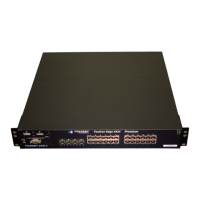Foundry Configuration Guide for the FESX, FSX, and FWSX
6 - 2 © Foundry Networks, Inc. December 2005
Foundry’s FSX (with POE daughter card) provides Power over Ethernet, compliant with the standards described in
the IEEE 802.3af specification for delivering in-line power. The 802.3af specification defines the standard for
delivering power over existing network cabling infrastructure, enabling multicast-enabled full streaming audio and
video applications for converged services, such as, Voice over IP (VoIP), WLAN access points, IP surveillance
cameras, and other IP technology devices.
POE technology eliminates the need for an electrical outlet and dedicated UPS near IP powered devices. With
power sourcing devices, such as Foundry’s FSX, power is consolidated and centralized in the wiring closets,
improving the reliability and resiliency of the network. Because POE can provide power over Ethernet cable,
power is continuous, even in the event of a power failure.
Terms Used in This Section
The following terms are introduced in this section:
• Power sourcing device/equipment - This is the source of the power, or the device that integrates the power
onto the network. Power sourcing devices/equipment have embedded POE technology. In this case, the
power sourcing device is Foundry’s FSX.
• IP powered device or Power consuming device - This is the Ethernet device that requires power and is
situated on the other end of the cable opposite the power sourcing equipment.
Methods for Delivering POE
There are two methods for delivering power over the network, as defined in the 802.3af specification:
• Endspan - Power is supplied through the Ethernet ports on a power sourcing device. With the Endspan
solution, power can be carried over the two data pairs (Alternative A) or the two spare pairs (Alternative B).
• Midspan - Power is supplied by an intermediate power sourcing device placed between the switch and the
powered device. With the Midspan solution, power is carried over the two spare pairs (Alternative B).
With both methods, power is transferred over four conductors, between the two pairs. 802.3af-compliant powered
devices are able to accept power from either pairs.
Foundry’s FSX POE devices use the Endspan method, compliant with the 802.3af standard.
The Endspan and Midspan methods are described in more detail in the following sections.
NOTE: All 802.3af-compliant power consuming devices are required to support both application methods
defined in the 802.3af specification.
Endspan
The POE Endspan method uses the Ethernet switch ports on power sourcing equipment, such as Foundry’s FSX
POE, which has embedded POE technology to deliver power over the network.
With the Endspan solution, there are two supported methods of delivering power. In Alternative A, four wires
deliver data and power over the network. Specifically, power is carried over the live wire pairs that deliver data, as
illustrated in Figure 6.1. In Alternative B, the four wires of the spare pairs are used to deliver power over the
network. Foundry’s POE devices support Alternative A.
The Endspan method is illustrated in Figure 6.1.

